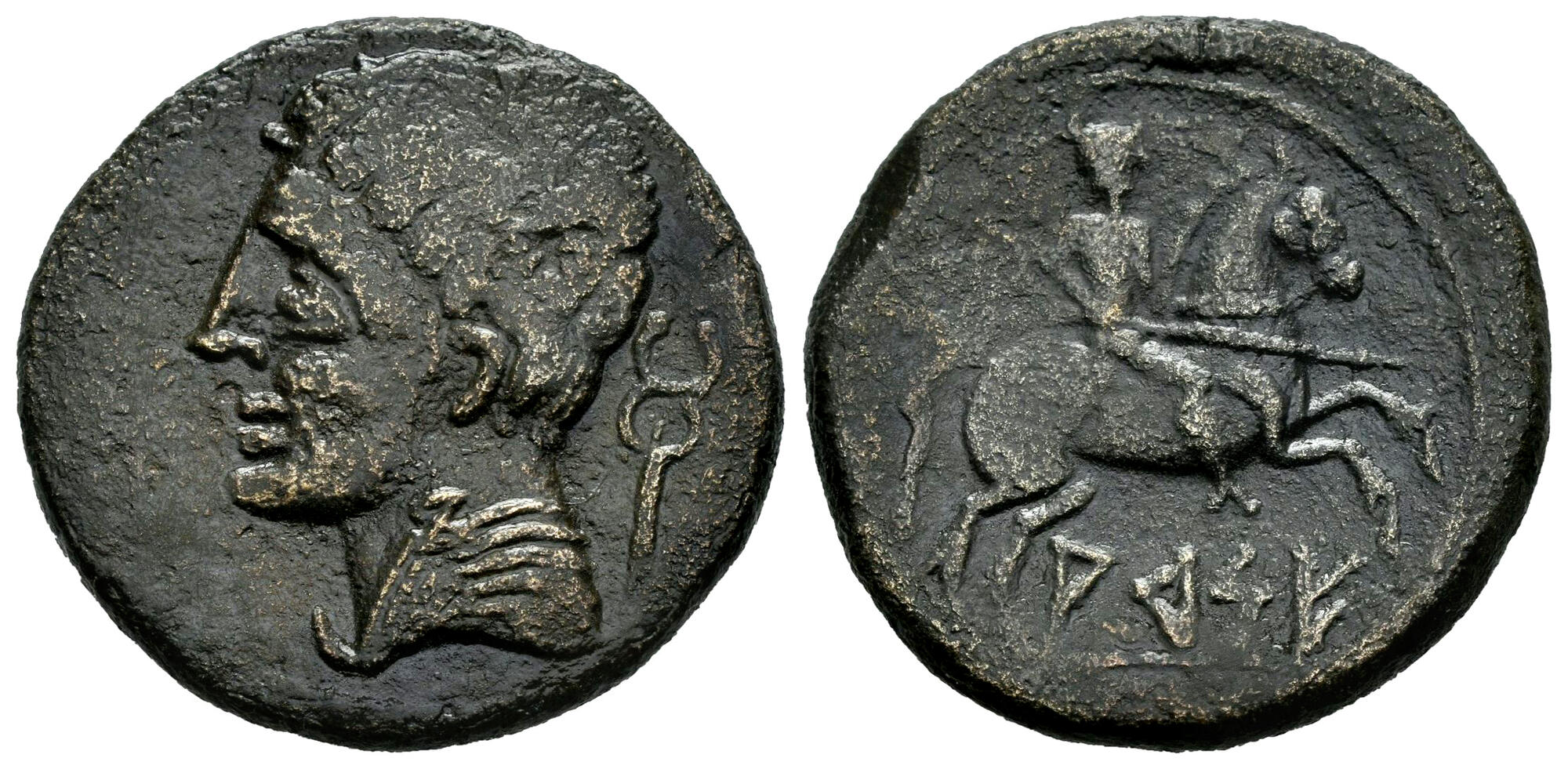S 1673 - Arse-Saguntum, bronze, units (195-130 BCE)
From SILVER
195 BCE - 130 BCE Bronze
Description
| ObverseInscription or printing placed on the obverse.: | Male head left, caduceus behind |
| ReverseInscription or printing placed on the reverse.: | (Iberic).Horseman right, holding spear, iberian legend ARSE. |
Mint and issuing power
| MintIdentifies the place of manufacture or issue of a numismatic object.: | Arse-Saguntum | Ancient regionAncient region.: | Hispania Citerior | Modern countryModern country: Spain | AuthorityIdentifies the issuing power. The authority can be "pretended" when the name or the portrait of X is on the coin but he/she was not the issuing power. It can also be "uncertain" when there is no mention of X on the coin but he/she was the issuing power according to the historical sources: | Roman Republic |
Chronology
| FromIdentifies the initial date in a range assigned in a numismatic context. | 195 BCE | toIdentifies the final date in a range assigned in a numismatic context.. | 130 BCE | PeriodTime period of the numismatic object.: Hellenistic and Imperial |
Physical description
| MetalThe physical material (usually metal) from which an object is made.: | Bronze |
Median weightMedian of the weights of numismatic objects (in grams). in grams | 13.50 | DenominationTerm indicating the value of a numismatic object. Examples: tetradrachm, chalkous, denarius.: | unit |
StandardStandard.: |
Image

S 1673 - Arse, bronze, units (195-130 BCE).jpg [1]
References
| Die study referencePublication of the study: | Ripollès - Llorens 20021Ripollès - Llorens 2002, p. 388-401 (Group VI: O70-80/ R91-103) | ||
| Coin series referenceReference to coin series study: | |||
Obverse dies distribution
| FrequencyFrequency of specimen in distribution. ᵖ | Number of obversesNumber of obverse dies. ᵖ (o) | % (o) | Number of coinsNumber of coins. (n) | % (n) | Die nameName(s) of the die(s). |
| 1 | 1 | 9.09 | 1 | 0.75 | 72 |
| 3 | 1 | 9.09 | 3 | 2.26 | 77 |
| 4 | 1 | 9.09 | 4 | 3.01 | 74 |
| 5 | 1 | 9.09 | 5 | 3.76 | 76 |
| 6 | 1 | 9.09 | 6 | 4.51 | 75 |
| 10 | 1 | 9.09 | 10 | 7.52 | 78 |
| 17 | 1 | 9.09 | 17 | 12.78 | 80 |
| 20 | 2 | 18.18 | 40 | 30.08 | 70, 73 |
| 22 | 1 | 9.09 | 22 | 16.54 | 71 |
| 25 | 1 | 9.09 | 25 | 18.8 | 79 |
| Total | 11 of 11 | 99.99 | 133 of 133 | 100.01 |
Reverse dies distribution
no distribution is available
Quantification
| Number of obversesNumber of obverse dies. ᵖ (o) | 11 | Number of singletons (o1)The number of singleton coins. ᵖ | 1 |
| Number of reverse diesNumber of reverse dies. (r) | 13 | Number of coinsNumber of coins. (n) | 133 |
| Coins per obverse dieNumber of coins per obverse die. (n/o) | 12.09 | Coins per reverse dieNumber of coins per reverse die. (n/r) | 10.23 |
| Reverse per obverse ratioRatio of obverse dies divided by reverse dies. (r/o) | 1.18 | Percentage of singletons (o1)number of coins (n) divided by the number of singletons (o1) ᵖ | 9.09 % |
| Original number of dies (O) (Carter 1983 formula)The estimation of the number of coins according to Carter 1983 ᵖ | 11.01 | Coins struck if 20,000 as average productivity per dieCoins made if the average productivity for obverses (according to Carter) is 20,000. ᵖ | 220,200 |
| Original number of dies (O) (Esty 2011 formula)The estimation of the number of coins according to the singleton formula in Esty 2011 ᵖ (O) | 11.99 | Survival rate if 20,000 as average productivity per dieSurvival rate if average productivity is 20,000. ᵖ | 0.00060 |
| Coverage (o = % of O) (Esty 1984 formula)Esty 1984 - coverage (% of O) ᵖ (o = % of O) | 99.25% | Die productivity if survival rate 1/2,000Average productivity if survival rate is 1/2,000. ᵖ | 24,159.85 |
| Weight of silver (in kg) if 20,000 coins per die (O = Carter formula)Carter 1983 * Median weight * 20000 (*10 if gold or electrum) ᵖ | n.a. | Die productivity if survival rate 1/5,000Average productivity if survival rate is 1/5,000. ᵖ | 60,399.64 |
Remarks
Most likely two workstations See chart of die-links p. 190
References
- ^ Ripollès, Pere Pau - Llorens, Maria del Mar (2002), Arse-Saguntum. Historia monetaria de la ciudad y su territorio, Sagunto, Bancaja, 564 p.